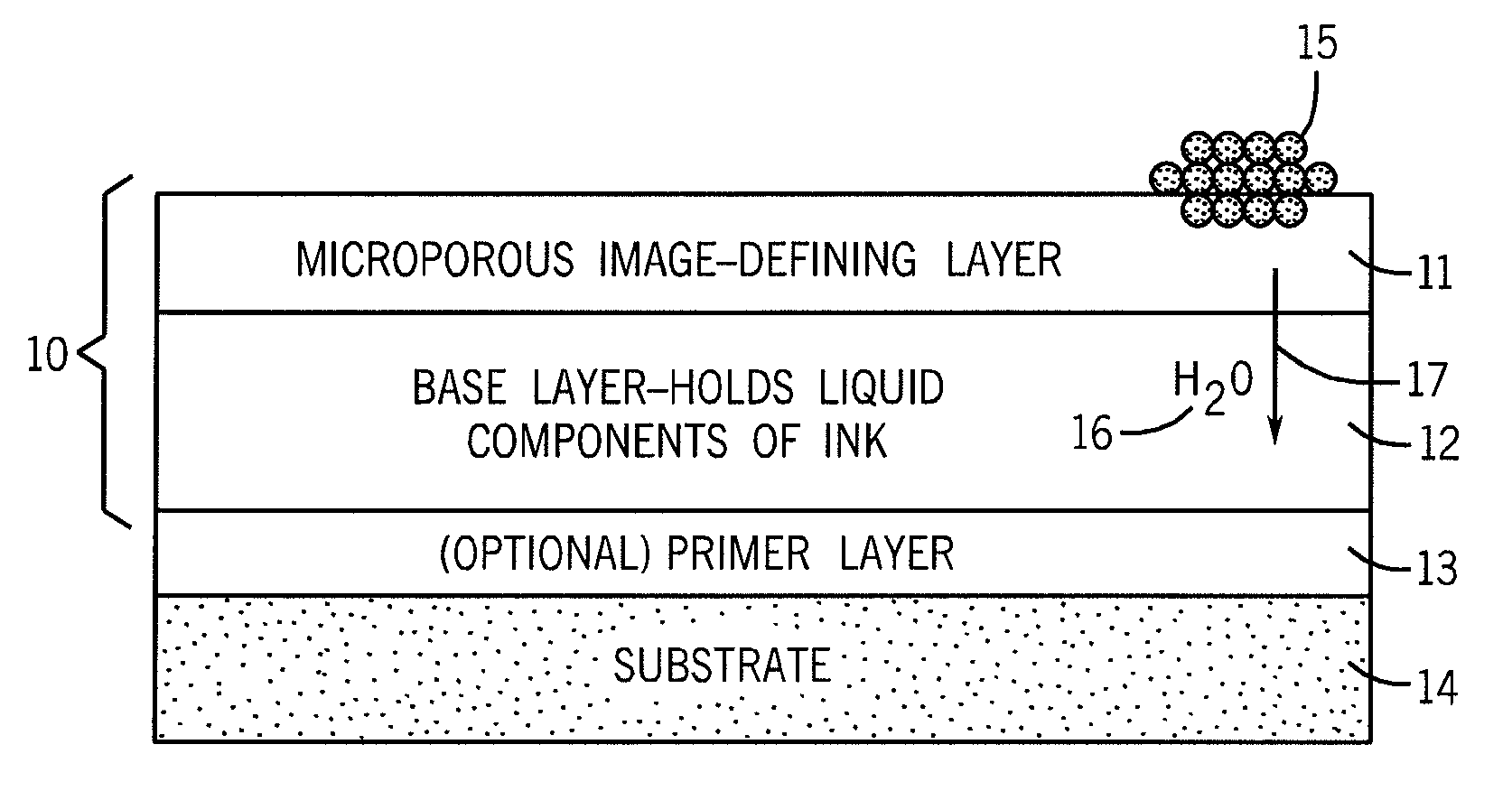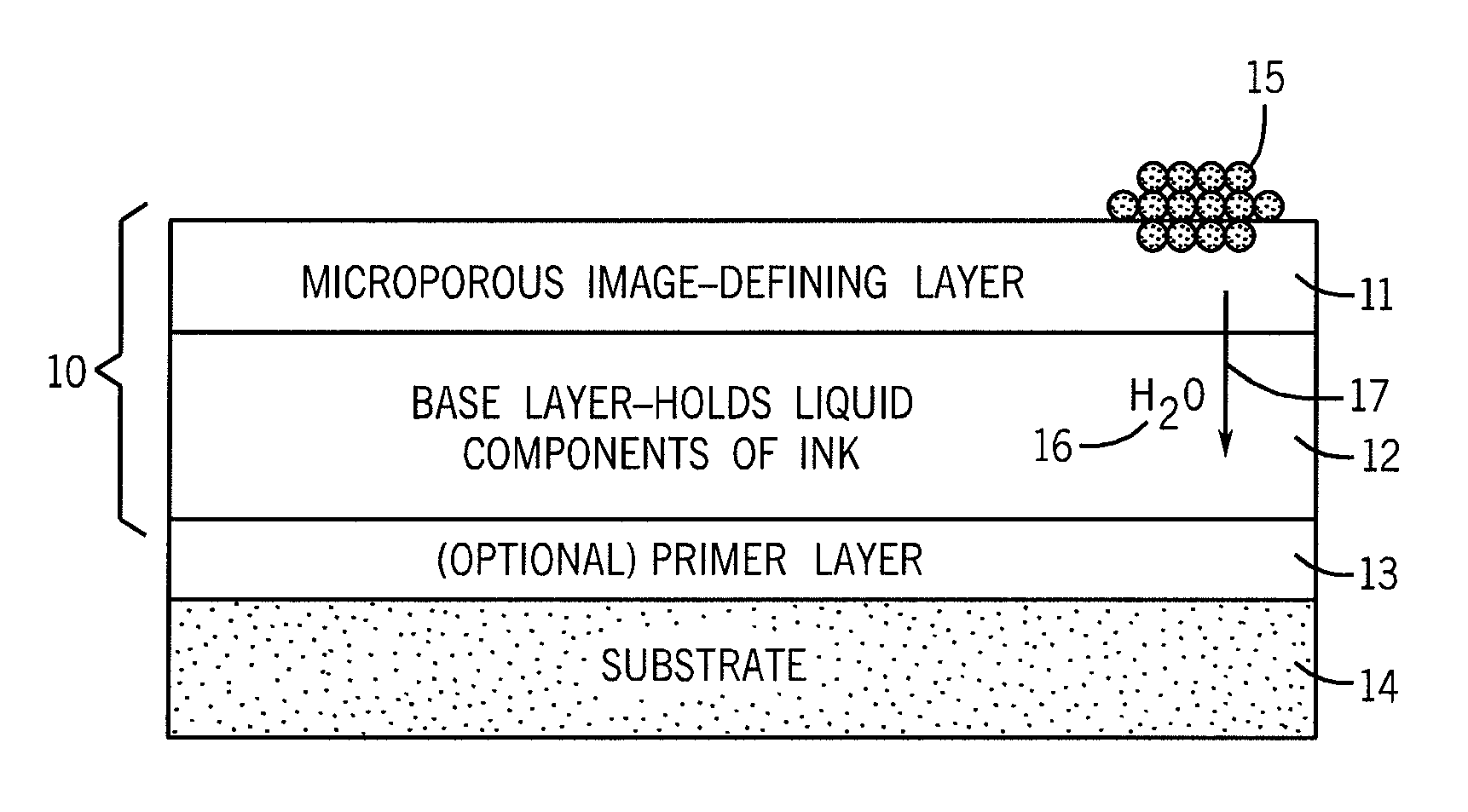Durable multilayer inkjet recording media topcoat
a multi-layer, inkjet printing technology, applied in the direction of instruments, transportation and packaging, thermography, etc., can solve the problems of inability to meet the requirements of printing quality, inability to print images with photographic quality resolution, lack of water and abrasion resistance, etc., to achieve excellent resistance to water and organic solvents, maximize color density and image definition of printed images, and high pore volume
- Summary
- Abstract
- Description
- Claims
- Application Information
AI Technical Summary
Benefits of technology
Problems solved by technology
Method used
Image
Examples
example 1
Materials
[0075]White, 2-mil MELINEX® 329 polyester film available from DuPont Teijin Films was used as the substrate. It was coated at a coat weight of 3.2 g / m2 with the primer formulation reported in Table 1.
[0076]
TABLE 1Primer FormulationComponentWeight (g)NeoRez R-967 Polyurethane Dispersion34Joncryl 617 Acrylic Emulsion34Di-ionized Water32Total100% Solids29.1NeoRez R-967 polyurethane dispersion is available from DSM NeoResins.Joncryl 617 acrylic emulsion is available from BASF.
The primer was coated with a base layer by a slot die at a dry coat weight of 11 lb / ream (17.9 g / m2). The formulation of the base layer is reported in Table 2.
[0077]
TABLE 2Base Layer FormulationComponentWeight (g)C812 Silica Dispersion (Table 3)54.0826% ELVAMIDE ® 8063 Solution (Table 4)40.5UV Stabilizer Subformula (Table 5)4.95Xama-7 Aziridine Crosslinker0.47TOTAL100% Solids21.7Pigment:Binder Ratio0.90Xama-7 aziridine crosslinker is available from BASF.
[0078]
TABLE 318.4% Syloid C812 Silica DispersionCompo...
example 2
[0082]The same substrate, primer layer and base layer were used as in Example 1. For the imaging layer, the formulation in Table 7 was used. The methanol was added very slowly with stirring to the Sylojet 710A aqueous silica dispersion to avoid precipitation. The ELVAMIDE® 8063 resin solution and UV Stabilizer Subformula were then stirred in, and the Xama-7 crosslinker was added just before the formulation was coated with a #6 Mayer rod for a dry coating weight of 1.5 g / m2.
[0083]
TABLE 7Imaging Layer Formulation 2ComponentWeight (g)Sylojet 710A silica dispersion24.80Methanol51.42ELVAMIDE ® 8063 Solution (Table 4)18.64UV Stabilizer Subformula (Table 5)4.94Xama-7 Aziridine Crosslinker0.20TOTAL100% Solids10.1Pigment:Binder Ratio1.05
example 3
[0084]The substrate, primer layer, and base layer of Example 1 were used. The imaging layer formulation is detailed in Table 8. The methanol was added very slowly with stirring to the Sylojet 710A aqueous silica dispersion to avoid precipitation. The ELVAMIDE® 8063 resin solution and UV Stabilizer Subformula were then stirred in. Dispal 11N7-80 boehmite alumina powder was added while the mixture was stirred with a Cowles blade at high speed for 30 min. The Xama-7 crosslinker was added just before the formulation was coated with a #6 Mayer rod to give a dry coating weight of 1.8 g / m2.
[0085]
TABLE 8Imaging Layer Formulation 3ComponentWeight (g)Sylojet 710A silica dispersion (20.5%)24.80Methanol48.88ELVAMIDE ® 8063 Solution (Table 4)18.64UV Stabilizer Subformula (Table 5)4.94Xama-7 Aziridine Crosslinker0.20Dispal 11N7-80 alumina2.54TOTAL100% Solids12.1Pigment:Binder Ratio1.47Dispal 11N7-80 is a boehmite alumina powder available from Evonik Degussa.
PUM
| Property | Measurement | Unit |
|---|---|---|
| number average particle size | aaaaa | aaaaa |
| surface energy | aaaaa | aaaaa |
| weight ratio | aaaaa | aaaaa |
Abstract
Description
Claims
Application Information
 Login to View More
Login to View More - R&D
- Intellectual Property
- Life Sciences
- Materials
- Tech Scout
- Unparalleled Data Quality
- Higher Quality Content
- 60% Fewer Hallucinations
Browse by: Latest US Patents, China's latest patents, Technical Efficacy Thesaurus, Application Domain, Technology Topic, Popular Technical Reports.
© 2025 PatSnap. All rights reserved.Legal|Privacy policy|Modern Slavery Act Transparency Statement|Sitemap|About US| Contact US: help@patsnap.com


